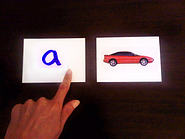Part 3 of 4: From Basic Vocabulary to Building Sentences
The most popular use of the Language Builder Picture Card Series is to build vocabulary. The realistic and current photos help students to learn the name of various nouns, occupations, and emotions. In the beginning, this task can be very repetitive and basic, focusing only on learning single-word responses. When a child with autism begins to gain expressive language skills, parents and educators are thrilled to watch how the child moves from basic vocabulary to building sentences.
Labeling Sentences
After a child has mastered numerous single-word labels for the picture cards, the next critical step is to build these one-word answers into more complete and functional Labeling Sentences.
Building sentences will start simply. As a first step you may just require the child to use the article along with the word. For example, move toward an answer of "an apple" or "a car". The next step would be to work toward "It is an apple" or "It is a car".
As you expand your student's communication skills to include full sentences, you will no doubt need to use prompts in the beginning. The most common method is verbal modeling. But it is important to fade the verbal prompt as soon as possible. To help your student answer in full sentences without need for a verbal prompt, you can move to a visual cue prompt.
 Written cue cards are a great method to remind your student to use full sentences. For example, if you show your student a picture of a car, and ask "What is it?" your student is likely to just answer "car". To prompt your student to use the article "a" with the word car, you can start by putting a cue card in front of the picture with the word "a" on it. Have your student touch each card (the "a" card and then the picture card) as they say the words "a car". The next step would be to add cue cards for "It is a car". When your student starts to grasp the concept of speaking multi-word sentences, you can begin to fade the visual cue card prompts.
Written cue cards are a great method to remind your student to use full sentences. For example, if you show your student a picture of a car, and ask "What is it?" your student is likely to just answer "car". To prompt your student to use the article "a" with the word car, you can start by putting a cue card in front of the picture with the word "a" on it. Have your student touch each card (the "a" card and then the picture card) as they say the words "a car". The next step would be to add cue cards for "It is a car". When your student starts to grasp the concept of speaking multi-word sentences, you can begin to fade the visual cue card prompts.
Requesting Sentences
Another important type of sentence that your child will need to learn to use is a Requesting Sentence. When your child learns to use communication to make requests and get their needs met, it will reduce the child's frustration, which will in turn reduce the frequency of tantrums and outbursts.
 Sort through the picture cards for which your child knows the labels. Find pictures of items that your child likes and that you have available to give to them. Food items are often the most successful to start with. For example: Cheese, Raisins, Juice, Popcorn, and Apple. Stick a magnet to the back of each picture and place the pictures on the refrigerator. Write the word "I" on one index card and the word "want" on another and place those on the refrigerator also. When you know your child wants a specific food (as most parents often do), pull the corresponding picture down into the "I want" sentence. Use the visual cues as a prompt to help your child remember to use the full sentence to request their desired food. As always, you should fade the prompts as your student begins to master this full sentence activity
Sort through the picture cards for which your child knows the labels. Find pictures of items that your child likes and that you have available to give to them. Food items are often the most successful to start with. For example: Cheese, Raisins, Juice, Popcorn, and Apple. Stick a magnet to the back of each picture and place the pictures on the refrigerator. Write the word "I" on one index card and the word "want" on another and place those on the refrigerator also. When you know your child wants a specific food (as most parents often do), pull the corresponding picture down into the "I want" sentence. Use the visual cues as a prompt to help your child remember to use the full sentence to request their desired food. As always, you should fade the prompts as your student begins to master this full sentence activity
A Note on Using Cue Cards to Prompt
You may think: Why am I using written words to prompt my child? He can't speak well, so what makes anyone think he can read?
The cards are not meant for your child to read. They are merely place markers. It makes as much sense to use the words as anything else. However, you could also use something as simple and nondescript such as blocks or blank cards for your child to touch as they say the words. The idea is to give your child a physical reminder to speak the extra words. In fact there are schools of thought suggesting that if you tie spoken words to physical activity that it creates more neural pathways for the words to attach to. Regardless, you can choose to use the word cards, or to use a more neutral object. Decide what works best for your child.
Read other articles in our Autism and Language series:
Part 1: Encouraging Emerging Language and Receptive Vocabulary

Angela Nelson, J.D., Ed.M.
Angela Nelson is the creator of the widely-recognized Language Builder Picture Card Series, and the creator and lead author for the Language Builder ARIS curriculum. Angela received her BA and JD from UCLA where she studied and practiced behavior psychology under Dr. Ivar Lovaas, and her Ed.M. at the Harvard Graduate School of Education, with a focus on technology innovation and education. As Founder and CEO of Stages Learning Materials, Angela has created autism, special needs and early childhood curriculum products since 1997. In addition to her duties at Stages, Angela writes for multiple industry publications and is Chair of the Education Market Association.





